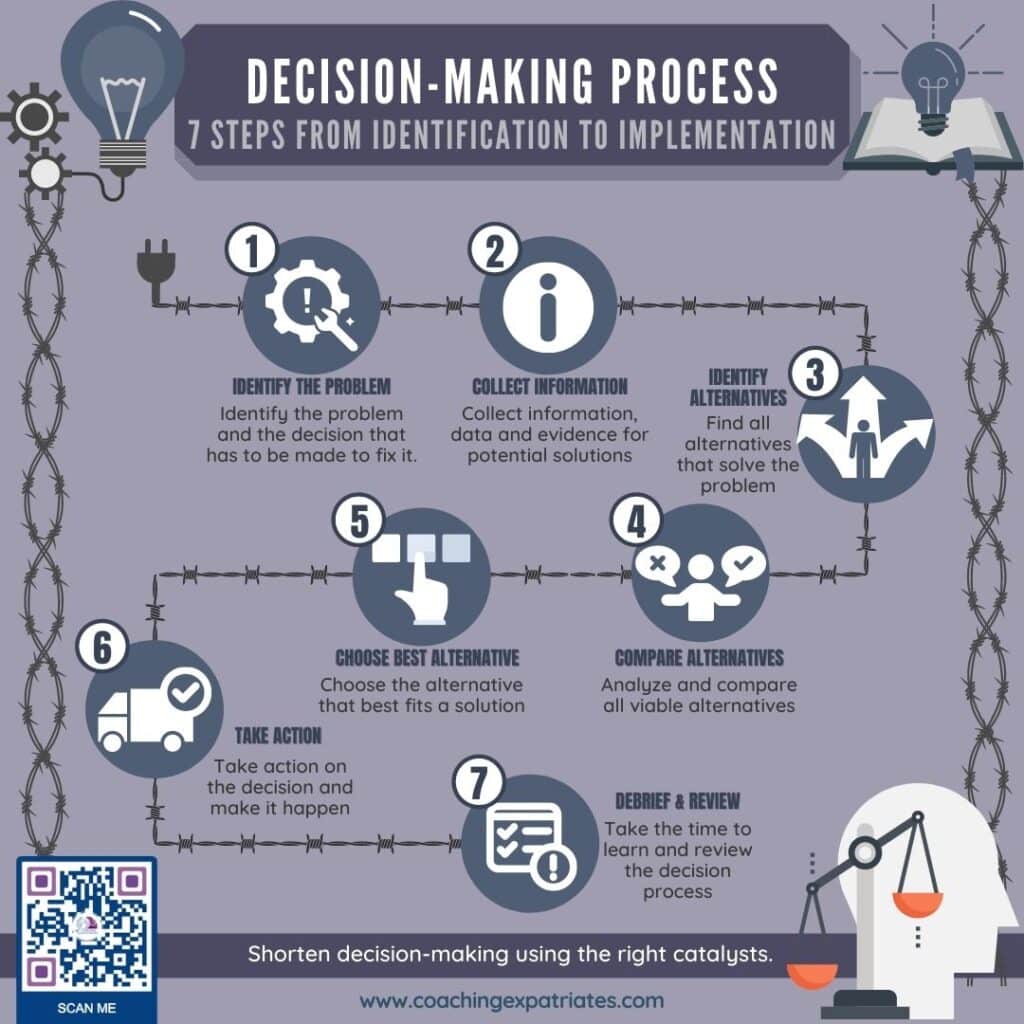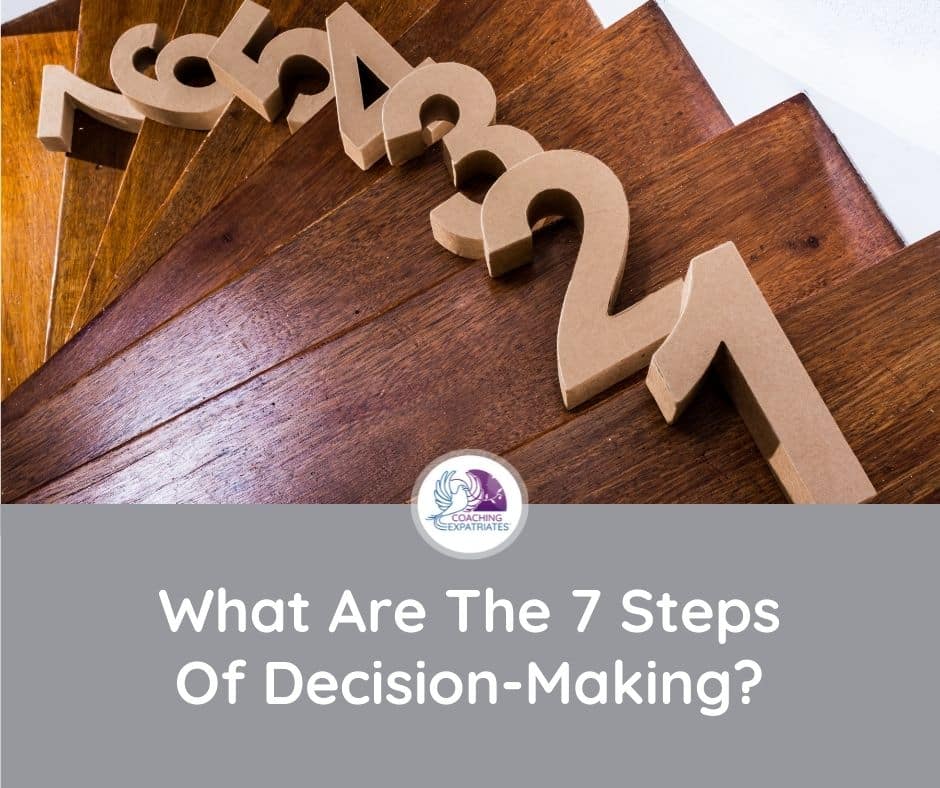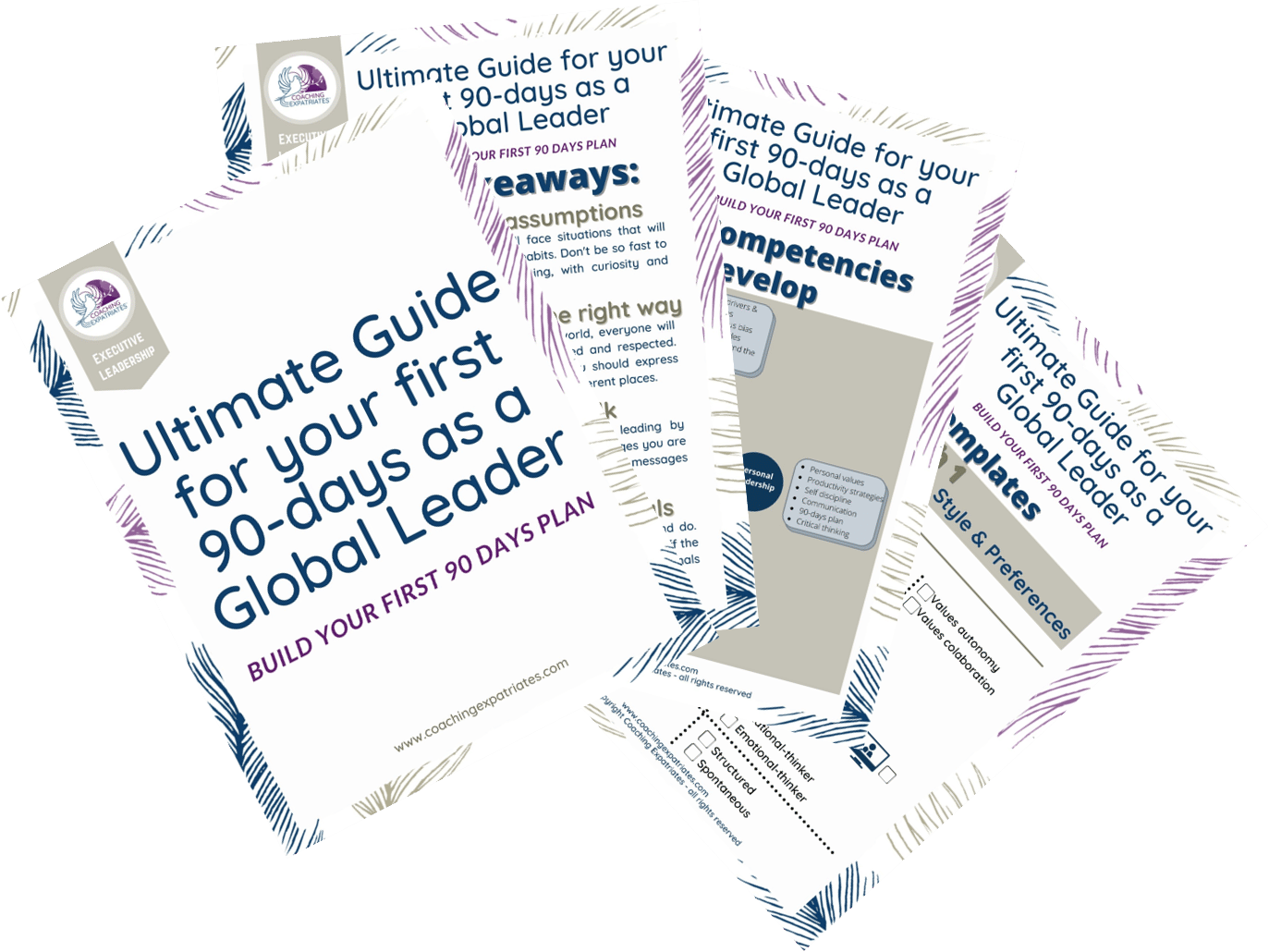Decision-making is the process of selecting a choice from 2 or more alternatives. This process consists of 7 critical decision-making steps, which we’ll discuss in this article today.
For important and impactful business decisions, the use of this step-by-step process can help you drill down into the right problem and prevent you from skipping steps or cutting corners.
Making decisions gives us power because it means we have options. And having options means we have some degree of control since we are at choice. And having some degree of control helps us make progress. There is no progress, no development, no accomplishments without making decisions. This is an important part of life, so it’s important that we learn this step-by-step process and implement it well.
From Identification To Implementation: Steps Of Decision-Making
Let’s see a step-by-step practical approach for your decision-making process: an easy approach to going from identification to implementation.
Step 1: Identify The Decision.
Global leadership is something tough. Sometimes it is difficult to drill down into the real problem. Not knowing what the real problem might be probably is one of the main roadblocks in decision-making.
For every problem you have, there are solutions. Well, for most problems, at least. Going from problem to solution is in its essence a decision-making process. To fix any problem, you basically have to select the best course of action to get to a solution. Identifying the decision is basically identifying what your real problem is and what is your goal or solution that you want to achieve. Therefore, identifying the decision to be made is critical.
Defining the nature of the decision can be difficult when you don’t know what the real problem is or when you misidentify the real problem.
I always like to give a personal example that a lot of people might relate to. Because I identified my problem incorrectly, I spent more money and more time making a decision than I wanted to. When I moved to a new house, I wanted a new shower. In the first step of the decision-making process, I identified the problem as being a need to select the best and most cost-effective shower head possible and get it installed. It turns out that we had flawed pipes and a flawed thermostat, so changing showerheads would not make our shower better and more cost-effective as we hoped. The real problem was needing to change pipes and structure in the bathroom before even thinking about showerheads.
When trying to identify the real problem that needs a decision, here are some questions to help you drill down into the right problem:
- What is the goal I want to achieve with this decision?
- What is my success measure?
- What other things might affect this problem that I am currently not considering?
- Who is an expert in this area that could help me brainstorm about other potential things affecting this decision?
- Can someone or something help me make a better assessment of the situation?

To illustrate how this could have helped me, I will answer the questions above with the example I just gave.
My goal was to have a good shower experience, with a nice flow of water, but by using water responsibly and also saving money as much as possible. My measure of success would be increasing the flow of water coming from the shower without any cost increase to the bill. In regards to other things that could affect this problem would be: the showerhead, the shower pipes, the water quality and hardness, the piping structure, and the water pressure.
This is no small list, but if I went through all these items to identify if they were part of the problem or not, things would have gone in a much smoother way. If I had hired a consultant plumber before, it would have cost me a couple of hundred bucks, but it would have saved me a couple thousand dollars for sure.
My biggest tip here is to make sure you are not assuming that you know what the problem is without first confirming that you are right. This could save you and your company a lot of time and money down the road.
Step 2: Collect Information.
Once you have identified your real problem and the decision you have to make to fix your problem, it’s time to start gathering information and collecting data and evidence to make a decision.
Collecting information is a tricky step. Because you can spend an absurd amount of time in it if you don’t know what you are doing. The best way to avoid losing time on this step is by starting this step by creating selection criteria. In step 1 you already asked yourself what the success measure of your decision would be. Now it’s time to tie some real metrics into that measure.
Once you created your selection criteria, you will gather information related to your criteria. For example: if you are selecting a new vendor for your HR training on diversity, you might have in your criteria that you have a cost Cap and that the topic of “Unconscious Bias” must be in the structure of the training. This means you will collect data from vendors regarding cost and regarding training structure. If other criteria are irrelevant, collecting other types of data might not be relevant.
As you can see, defining your criteria and what’s important for you is a critical element in the step of collecting information. If you do this part right, collecting data is just a matter of spending time doing good research and investigation.
Step 3: Identify Alternatives.
While you are collecting information and digging into possibilities, you will naturally find possible alternatives and paths of action. However, like with brainstorming, not all alternatives are acceptable. So in this step, you will identify which are the alternatives that you want to use for analysis and comparison in the decision-making process.
Depending on the project or decision you need to make, it’s a good idea to bring several people into the discussion. You can have a brainstorming session and mind-map the alternatives that you are getting. You can also do a decision-tree analysis, which comprises of you drilling down into an alternative and understanding what needs to happen step-by-step once that decision is made.
For example, let’s say you want to change your warehouse to a location closer to a port of entry. You have several real state options to choose from. In the decision-tree you will map what would need to happen in each alternative if they were selected. Real state A is in good condition, so no remodeling and safety adjustments would have to be done, but it does not contain your product’s proper storage technology. Real state B needs remodeling and adjustments to health and safety compliance, but it already does have the storing technology for your product. You’ll have to choose different providers to perform different projects with varying costs in your decision-tree. By doing a decision-tree analysis, you can clearly analyze your possibilities and map them out well for the next step.
Something very useful in this step is excluding “Deal-Breakers.” Deal-breakers in decision-making are those elements that immediately exclude alternatives. For example, let’s say you have to decide where your next Company’s Annual Conference will be. You would love to choose the Flanders Meeting and Convention Centre, but it’s cost-prohibitive compared to your budget. So, that option is a deal-breaker in this context, so you would exclude it right away, even before comparing.
Step 4: Compare Alternatives.
Once you have defined your problem and goal, you have your selection criteria, and you have your alternatives mapped out, it’s just a matter of comparing the alternatives.
First, you will get your selection criteria and compare each alternative’s criterion, one by one. You will then include all evidence you collected for each alternative, while collecting the data. You will compare and weigh each one of them. Then, you will filter your alternatives, so that the decision can become less overwhelming. If you have 20 alternatives to choose from, this selection becomes more difficult.
You can filter your options by adding a new criterion to your selection until you have only 3 to 5 options left to compare. Once you have fewer options, comparing them becomes a lot less overwhelming.
Here are a few Decision-Making comparison tools that you can use for analyzing your options:
- Weighted Decision Matrix
- Decision-Tree Analysis
- Pros And Cons Analysis
- SWOT Analysis
- Force Field Analysis
- Cause-Effect (Fishbone) Analysis
Each of these Decision-Making Tools is best suited for different types of decisions.
Step 5: Choose The Best Alternative.
If you worked on the previous steps diligently, choosing the best alternative is a matter of identifying which alternative best fits your selection criteria. In this step, you will get all the comparisons you made in the previous step so that you can make your final choice that will address the problem that you identified in Step 1.
One thing to note is that sometimes, the best alternative is none of the options you were comparing but rather a blend between more than 2. You will notice that you will be challenged to be creative, problem-solve on a new level, and make use of critical thinking skills during your decision-making process.
One final tip I have is about documenting the decision. The more informative and detailed you are in the documenting process, the easier it will be in the future to explain your rationale and prove your transparency process.
In many high-risk countries where the corruption index is high, providing evidence that you are transparent and adhering to rules and laws is critical. It is also a massive differentiator in the long run. By having a solid documenting process and procedure, you can make sure you are making unbiased decisions that are law-bound.
Step 6: Take Action.
This is what I can tell you from this step: if you defined well your decision criteria, created a decision-tree to analyze and deep-dive into the alternatives, and made good notes when choosing the best alternative, it’s a matter of organizing all these data into a project plan with action steps.
Very often, the decision-makers in corporations are not the same as the executioners of the decision. In other words, who gets to decide is not the same as who gets delegated to implement the decision.
This disconnect is usually where most corporations create failures, even though the decision might have been the correct one. The decision-making process does not stop once the decision is made. Taking action and implementing your decision is still part of the decision-making process. Not taking action on a decision is the same as not having made the decision in the first place.
Here are a few tips for this step
- Project Plan. create a project plan before handing the decision implementation over to the delegated team or person
- Document. Document all the prior steps above in detail so that they can be referred back to if needed
- Track. Use a tracking system or online tool to track your project plan and decision implementation
Here are some good tools for tracking your decision implementation or project plan
Step 7: Decision Debrief.
One of the biggest mistakes most corporations make is never reviewing a decision after it’s made and implemented.
Taking the time to review a decision and learn from it and its process is called Decision Debrief or Adjourning. This is an important moment and step in the decision-making process because it’s a time when all decision-makers will learn and connect dots that will be valuable for their career and experience.
Here are some points of discussion for your debrief session:
- what went well, and what could have been improved during this process?
- what could we have done to make this process faster and more cost-effective?
- what were the results of this decision versus the expectations we had in step 5?
- how well did we do in selecting the proper criteria?
- how well did we do in using the right tools for analysis?
- how well did we do in creating the project plan?
- how well did we hand over the project to the implementation team or person?
- how well did we track the progress of the decision-making process and its implementation?

How To Shorten This Process When Making Decisions Inside A Corporation?
The step-by-step decision-making process outlined above can be exhausting and time-consuming, especially for big and impactful business decisions involving groups. I get a very common question from my clients: “how can I shorten this decision-making process and keep its effectiveness?”
Shortening the decision-making process can be done in 3 ways:
1- Using Decision-Making Catalysts For Each Decision-Making Style.
Each decision-maker style has its own way and pace of deciding things. In a previous post, you learned that there are 6 different styles for decision-making, and each style value something different. Using the right narrative or “catalyst” that ties with the decision-makers’ values can catalyze people’s decision process. In other words, by helping people get what they need for making the decision, you can help them make faster decisions. This is called using the right decision-making catalysts for each style.
By catering the right narrative to the right decision-maker style, you can catalyze steps 2, 3, 4, and 5. You will work on these steps for that to happen, having the right decision-maker style – and their values – in mind.
For example, if you have a data-driven decision-maker, you’ll want them to participate in the collection and analysis of data. This way, they will feel more knowledgeable and confident about what they are learning and will have all the elements they need to make a more confident decision. On the other hand, if you have a productive decision-maker, you’ll want to work on the gathering and analyzing phases first, compile all the data into a business case, and pitch them the relevant and most important aspects of the choices and recommendations. You will flex your process according to each style.
2- Using Business Acumen Catalysts.
As you learned, making the decision is not the end of the process. Taking action is also an important step in the decision-making process. Each company has its own way to make decisions. There are power structures in place, as well as rules and procedures that might be regulated by a Power Of Attorney Chart (POA) or a Power Of Decision Chart (POD). Decisions must be made according to these rules and power structures.
Similarly, companies go through different ways when implementing projects and decisions. Each company has its own structure and way of doing things.
The more business acumen you have and know how your business works, the better you will learn how to navigate these structures and fasten the decision-making process for steps 5 and 6.
3- Using Decision-Making Catalysts For Styles And Business Acumen Catalysts.
The third option, which is actually the faster option, is to use both catalysts to make the decision-making process faster: using the right narrative to the right people and also using your business acumen to navigate the decision-making process inside your corporation more effectively.
Not always it is possible to use this combination. For example, if you have a large group of decision-makers or you are making a decision that involves group decision-making, your audience might not have a homogenous style to use the right catalysts in steps 2, 3, 4, and 5.
Similarly, you might not be able to use business acumen for fast-tracking decision-making. You might be faced with decisions involving external providers, clients, and parties, for which your business acumen might not be as effective unless you have business acumen and influence over these external parties.
In whatever case, you should try to use this combination whenever possible.
Tools For Better Decision-Making
Tools For Comparing Alternatives.
We talked a little bit about some of the tools you can use when comparing alternatives and making analyzis. Here I want to share a few more for you to consider:
- Weighted Decision Matrix
- Decision-Tree Analysis
- Pros And Cons Analysis
- SWOT Analysis
- Force Field Analysis
- Cause-Effect (Fishbone) Analysis
- Cost-Benefit Analysis
- Risk-Analysis
- Multi-voting
- Pareto Analysis
- Pay-off Analysis
As we said earlier, mastering each of these tools is a task as each has its own benefits and is best suited for specific situations and decisions.
Tools For Tracking Progress & Project Plans.
- Click Up
- Asana.com
- Notion
- Trello
- Smartsheet
- Project Manager
- ActivTrak
- Microsoft OneNote
- Evernote
- Wrike
How To Choose The Right Project Tracking Tool?
Choosing the right tool for you and your team is a matter of preference.
My tips for choosing the best tool is focusing on:
- data security and protection,
- cost-effectiveness,
- scalability,
- sharing capabilities (both team sharing and external sharing with privacy options)
- customization capabilities,
- ease of use and learning,
- ease of deployment,
- data extraction (For example export to .csv or .xls)
Currently, my favorite tool is, by far, Click Up. I was an early adopter of this tool, and I am absolutely amazed at how much they grew and how much you can do with their tool. They certainly check all the boxes above without breaking the bank; that’s why I love it.
Final Thoughts
Whether you are faced with the task of making a decision on behalf of your corporation or a personal decision, you can rely on this step-by-step guide and tools recommendations to prepare for your task ahead. They are simple and easy to use, and you can achieve great results when implementing them.
If you are interested in developing further your decision-making skills and want to learn how to help corporations make faster decisions, check out our online Global Executive Leadership Program. We go over all 4 success pillars of Global Leadership during 9 online modules, including 2 dedicated modules on Organizational Leadership, where decision-making falls under.
In case you have specific decisions or projects in mind that you want to drill down or a situation in which you or your team feel stuck, you can purchase one of our executive coaching packages. We can help you sort the issue or topic out during your program and find the best course of action to make things better for you and your team. Executive coaching can be incredible support when it comes to navigating decision-making requirements, and many high executives make constant use of it.
If you enjoyed this post, consider subscribing to our newsletter using the form below. We focus on providing good content to global leaders and executives who want to make impactful business decisions and be more inclusive and influential. We know your inbox is sacred, so we email just once per week, and we never sell your information. Trust is the basis of Global Leadership, and we fully honor it.







